Become part of the family
Get inspiration, new arrivals and the latest offers to your inbox
Shop our Spring Savings now
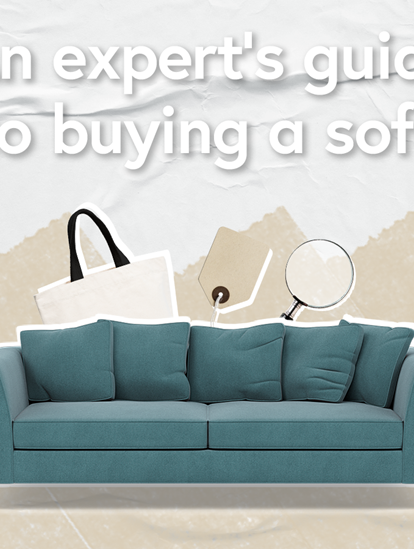
We want you to feel passionate about your new sofa. To fall in love with the style, luxuriate in the materials and marvel at how well it fits into your space. But to do that, you need to be equipped with the right knowledge to make the best decision for you.
This guide is a combination of practical tips for choosing the right sofa size, shape and material for your home – but it’s also a window into the emotional side of buying such a central piece of furniture.
Online, you’ll find all sorts of guides that say the same things over and over again – because they all borrow from one another. At Sterling, we’re doing things differently by including insight from one of the industry’s leading sofa experts, Malcolm Walker.
So, if you’re considering a new sofa, you’ve found the perfect resource to help you make a sensible yet spectacular decision.
Before we delve into the guide, we’re sharing some quick tips from our expert to keep in mind when browsing sofas online.
You can order swatches online or see them at one of our stores to ensure that the material you're interested in truly fits in with your home decor.
Sofas come in a variety of configurations based on both utility and design aesthetics. Artistic and cultural movements often lead to design choices, whereas functional style options like recliners have come as a result of the changing habits of human life.
Each generation tends to produce a specific trend, which is then absorbed into a cultural pool that subsequent generations benefit from. Take the classic Chesterfield, for example, which came about in the 1700s during a period in which elegance and regality were a sign of social standing. Still popular today, Chesterfields exemplify the concept of ‘style is timeless’.
Let’s take a look at the most popular styles and types of sofa to help you learn more about each of them. Before we explore the aesthetic styles available, we want this guide to start in the most practical way: choosing the right type of sofa to suit your needs.
The back of a sofa is responsible for a large part of its overall profile. The back height is important as it dictates how a sofa looks in the room – a tall sofa may clash with low windows.
Cushion back: these sofas have fitted cushions which fit perfectly to the back of the frame. Requires regular care to plump and turn the cushions to ensure even wear and longevity.
Fixed back: a firmer sofa where the back is filled and upholstered as one piece. A lower maintenance option, but comfort is always a personal choice.
Scatter/pillow back: as the name suggests, this sofa uses a loose arrangement of multiple pillows for a relaxed look. The comfort of a scatter sofa varies depending on personal taste and pillow arrangement.
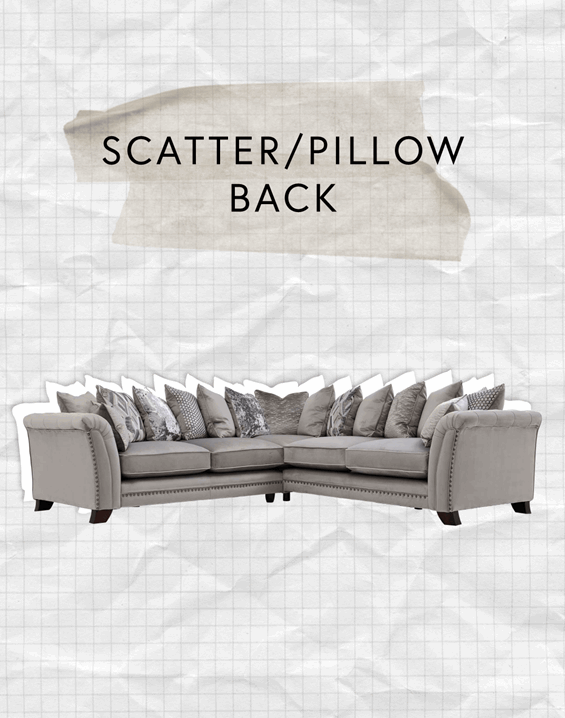
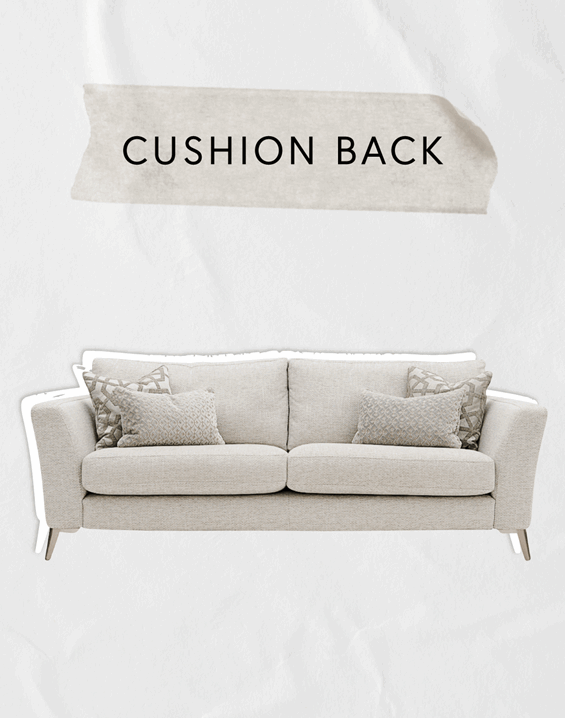
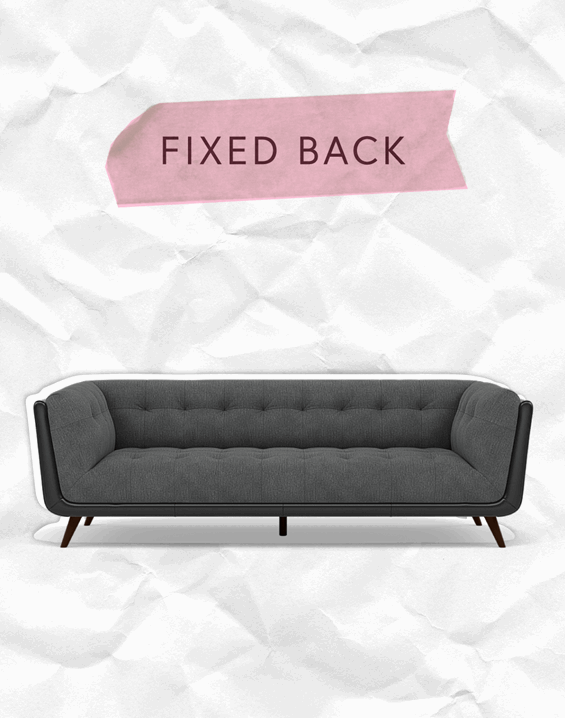
Sofa arm types come in all sorts of shapes and naming conventions, depending on the manufacturer. There are rolled arms, square arms, flared arms and more. Instead of diving into each, we think it’s better to share general guidance:
Wider arm styles will make the sofa look bigger and therefore occupy more space.
A narrower arm can help maximize seating space, and work well in compact spaces.
Modern flared and angled arms will take up as much space as scroll or curved ones, so don’t be fooled into thinking modern always means sleek.
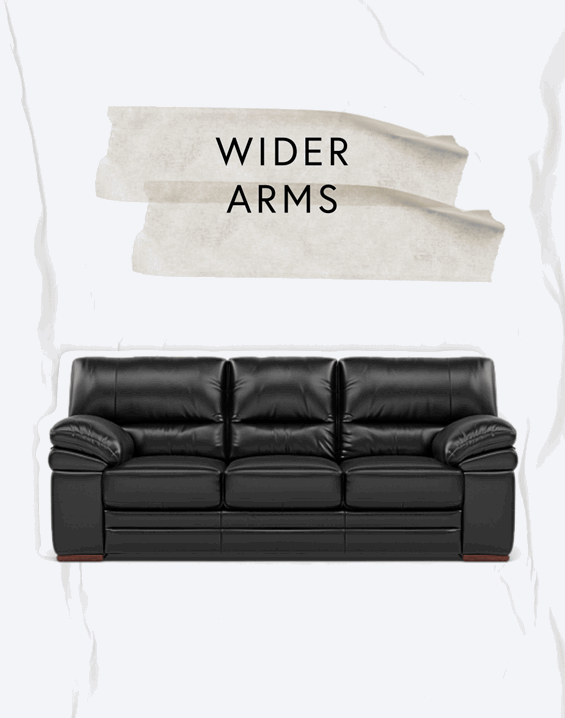
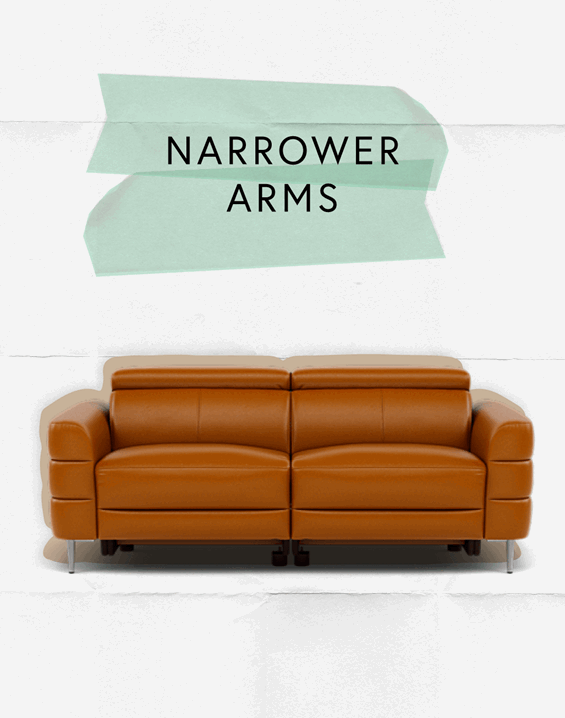
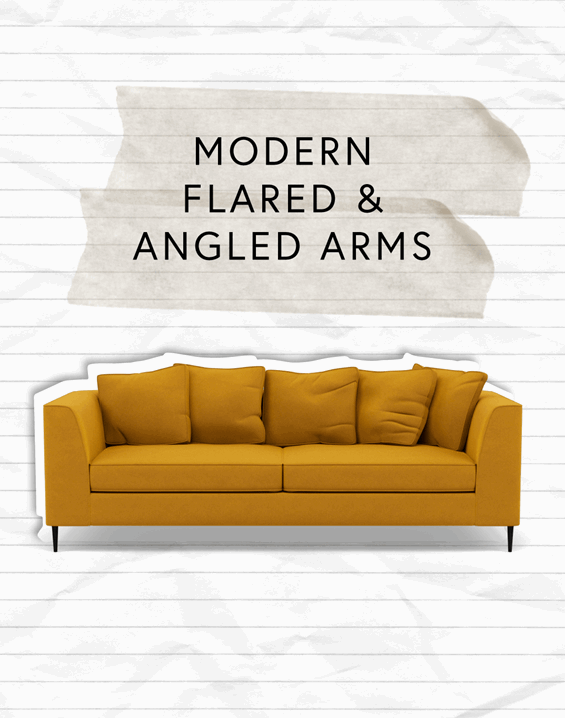
Sofa legs are even more varied than arms, with options ranging from taller stiletto and splayed legs through to minimalist platforms or glides. The main consideration as a buyer is to choose legs that you like the look of and which fit your space. However, there are other tips to think about too:
Taller legs are more prone to visible wear and tear – so be careful when vacuuming or moving around the sofa. Painted wooden legs can chip and peel, which in turn will make the sofa look prematurely worn.
Low legs tend to ground a sofa in the room, giving them a more architectural feel.
Ensure whichever legs you choose have rubber protectors on the feet to keep the carpet or flooring safe.
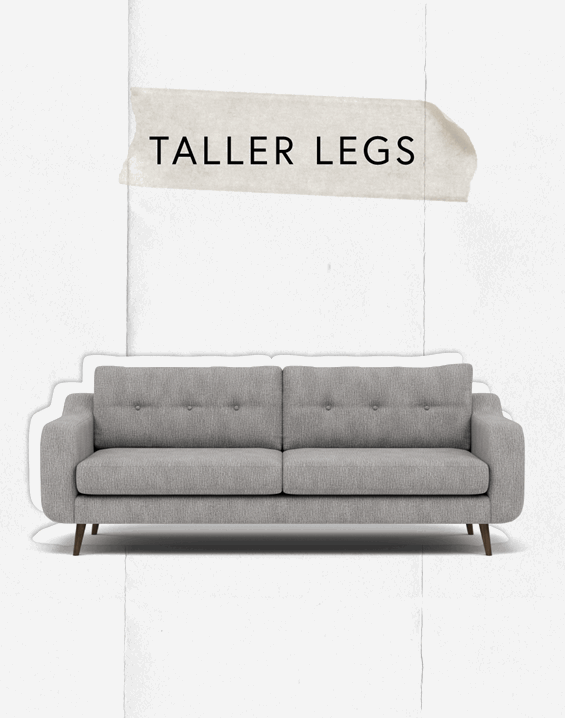
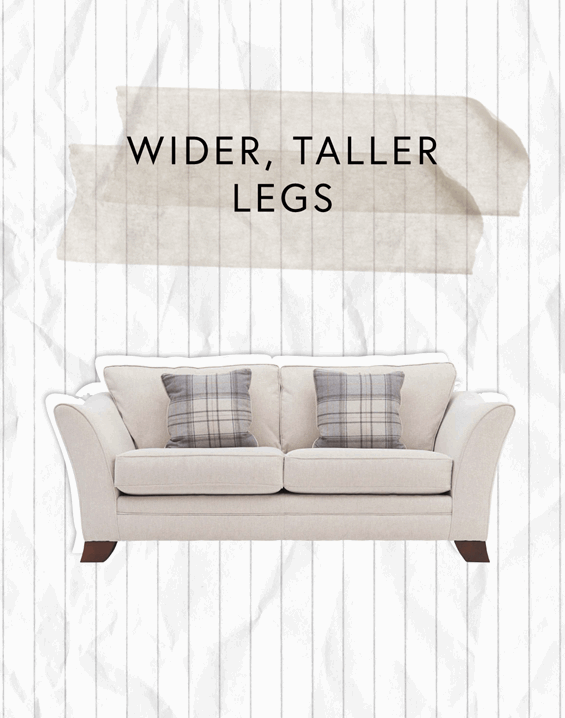
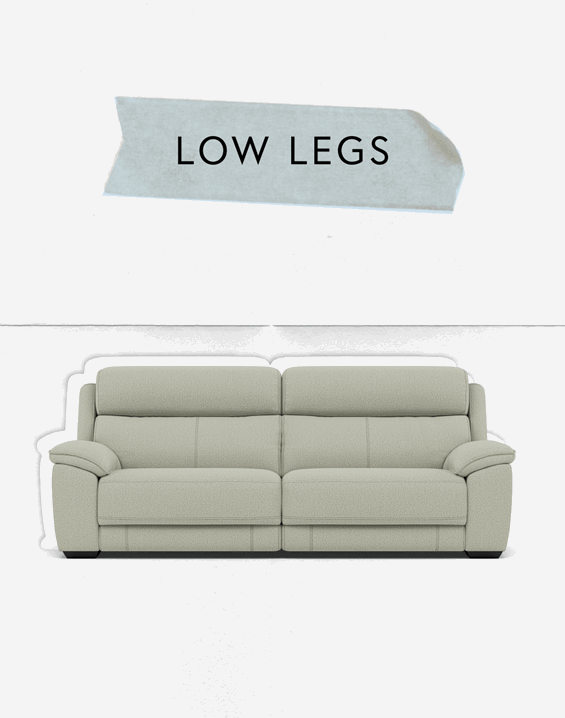
The best way to decide on your sofa is to think of its utility first – what do you need the sofa for? What function will it fulfil in your home? How many people will use it? Deciding on the size and features of a sofa is the best way to start your journey, as it will also help lead you to the right material and aesthetic choice too.
On our website, we have several categories for sofas, though within those categories are certain sub-styles. Here’s an overview of each to help you understand which may be right for you.
Let’s start with the classic rectangular sofa, generally available in configurations of 2, 3 and 4-seater. This is the classic type of sofa, though each model you choose from will have individual style choices such as higher arms, lower seat depth, higher backs, lower backs, etc. The material you choose will also impact the final product and the way the sofa sits.
Our advice here is relatively simple: if you’re going for the classic shape, we’d encourage you to understand your home’s limitations and choose a sofa that will fit in your room without overpowering the space. Consider the future, however, as a sofa is a long-term investment, and your household may grow in size over the coming years.
Traditional sofas with plenty of options for style, material and seats
Purchase any accessories such as a footrest at the same time as your sofa to avoid a mismatch of colours or fabrics if purchased later– but be sure to measure the space for those accessories too.
The traditional corner sofa has a distinctive right-angled, l-shaped design so it can fit into the tricky spaces in your home. A corner sofa isn’t to be confused with a chaise sofa, which has an open, extended ‘chaise’ section – corner sofas have arms at both ends and a back that encompasses the entire seating area.
If corner sofas have one side longer than the other, they have two options to choose from: left and right-hand facing versions. The orientation is determined by whether the corner and the shorter section are on your left or right when facing the sofa.
If a corner sofa doesn’t have left or right options, it means that both of its sides are equal in length, so they will look the same regardless of how you place them.
L-shaped corner sofas aren’t the only options – there are U-shaped and C-shaped sofas, too – all available to suit your perfect living space.
Chaise sofas are a popular modern option, designed with lounging in mind. The backs and arms of the sofa don’t extend to the chaise section, giving you plenty of space to unwind. They tend to be smaller than corner sofas and are often used as a more casual alternative to traditional L-shaped sofas.
The chaise end of a sofa is the perfect option for those who don’t want to buy a separate footstool.
Lots of chaise-end sofas offer a hollow storage option within them, so they can help you declutter your space.
Can’t decide between a corner or a chaise? Choose a modular sofa, which comes with modular blocks that can be customised to create something more appropriate to your room and taste. Remember that despite the ‘modular’ name, it’s best to buy everything together in the configuration you want – you can’t rely on changing a piece later as the item may end up discontinued.
Offers flexibility in how you design the sofa around your space and can be reconfigured to suit new requirements.
Due to their design, modular units may separate or form gaps, forcing you to regularly restore the shape.
Custom modular sofas have longer lead times than other sofa types.
Recliner sofas are the ultimate choice for personal comfort and customisation. The wide range of trendy designs and options has made recliners the most popular type of sofa on the market. In fact, our expert thinks as much as 40% of the sofa-buying market opts for a sofa with reclining features.
A recliner, unlike a high or low-back sofa, can generally provide more versatility thanks to adjustable headrest heights. This helps it fit into the room but also provides optimal comfort.
Offers more support and comfort than other forms of sofas, with more adjustability and customisation to find the right ‘sit’ for you.
Delivered in sections and installed by our delivery experts, making access considerations far easier.
You can choose between traditional manual recliners and fancy power recliners.
A sofa bed can come in any of the styles above, but has a built-in fold-out bed section. It can be an elegant solution for smaller homes that want to host guests. There are foldout and pullout sofa beds on the market.
A 2-fold sofa bed unfolds once and allows you to use a thicker mattress, whilst a 3-fold bed requires more unfolding and therefore has less structural stability, so needs a thinner mattress.
Pullout sofa beds are also very popular. When the bottom part is pulled out with the strap handles, the extension pops up from under the seats to make a comfortable bed.
Our most popular design is our super comfortable Nicoletti Carlotta two-fold sofa bed that converts from a sofa to a comfy bed in seconds.
There are some iconic design styles within the types we’ve just listed. Some of them, like the Chesterfield, are distinct and unique. Others, such as sofas named ‘contemporary’, will generally be one of the types above with specific material and colour options.
What is a Chesterfield sofa? The Chesterfield sofa is one that carries immediate connotations of luxury. It’s a stately, timeless style that has remained popular for generations. The Chesterfield is instantly recognisable thanks to its shape, which is a low back framed by high, rolled arms and the iconic deep buttoning and pleats. The are very fashionable currently.
Whilst the original design dictated a dark leather material finish, Modern Chesterfields have experimented with different choices such as fabric and synthetic leather. All convey the same sentiment: this sofa belongs to someone with style.
Our expert, Malcolm, is a Chesterfield enthusiast: “I own a Chesterfield, and it’s really just a beautiful piece that I appreciate. It needs upkeep and maintenance to look its best, but it fills me with joy when I look at it, and that’s why I own it.”
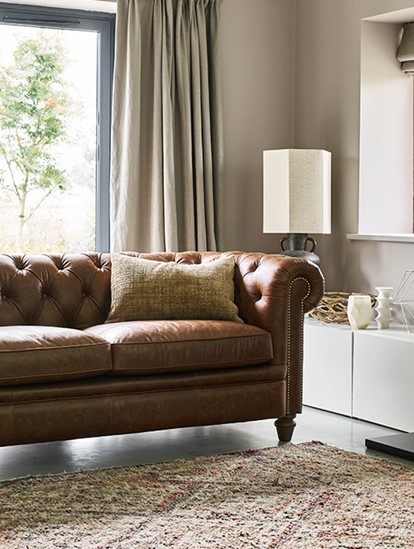
Mid Century is a style that dates back to…you guessed it, mid-century. The 1950s and 60s saw a torrent of new ideas, styles and beliefs all melting together to create one of the most expression-packed eras in history.
From this period came a defined style known as Mid Century modern, which blended the flair of the past with the new technologies and style preferences that became available to designers. Sleek and sophisticated whilst still relaxed, the style is perfect for sofas.
What makes a mid-century modern sofa is a little more subjective than Chesterfields, but we’d say that it’s a combination of slim arms, angled lines and splayed feet.
Industrial decor is about mixing leather, metal and wooden elements, and textured fabrics. Industrial sofas are usually robust in darker colours with either taller, exposed metal feet or low legs, giving the couch a masculine look. However, you can still use brighter-coloured fabric sofas to soften the look of your otherwise industrial decor in your living room. So, you’ve got plenty of options if you’re aiming for an industrial-styled home.
The materials making up your sofa aren’t just about aesthetics. Each material type has its own impact on maintenance requirements, longevity, comfort and more. Here’s a brief overview of how each type affects the final ‘sit’.
The frame of a sofa is the skeleton upon which your upholstery is applied. It provides the base support for the entire piece and is critical to durability.
Wood: wood is a long-lasting natural material that has been used in sofas for generations. A wooden frame is both stately and durable. Different types of wood are available, with hardwoods generally being used on load-bearing areas due to the stresses a sofa is exposed to.
Metal: metal frames are more popular in modern styles, especially when partially exposed in industrial and architectural designs. Metal frames are usually made from steel or aluminium and are naturally fire-resistant, highly durable and immune to rot or mould.
Plastic: some budget and outdoor sofas use robust plastic frames. These offer good durability but tend to be less attractive than wood or metal.
The fabric you choose for your sofa is as individual as you are – but there are some guidelines to bear in mind. Technologies have changed over the past few years, bringing new appeal to certain fabrics.
When choosing a fabric, be practical. A leather sofa may look fantastic, but if you have a large family with lots of young children, it can be hard to maintain the leather, and it may be more easily damaged.
A leather sofa is made from durable natural leather, typically cowhide, which provides long-lasting durability and character. However, there are different types of leather, and each impacts the overall feel of the sofa.
Aniline leather: this is leather which has been through-dyed, allowing the natural grain and grooves to show through. It requires more maintenance than other options.
Semi-analyne: uses a surface coating to add protection but still shows some natural grain.
Full leather: fully sealed leather is more family-friendly but has less natural character.
Italian leather: this is the premium upmarket choice and refers to the highest quality leather, produced in Italy with all of the natural grain retained.
There are lots of different types of fabric on the market, all of which offer their own unique characteristics. Natural fabric includes:
Cotton: a natural material that is used in clothing and furniture, cotton is comfortable and relatively durable. 100% cotton is generally resistant to wear, fading, and pilling, cotton is another one of the most durable fabrics for upholstered furniture.
Cotton blend: a blend of cotton and another material to add strength to the weave.
Linen: is considered to be one of the most comfortable fabrics, making it a logical choice for upholstery fabric. Linen is naturally moisture resistant. It has a relaxed, lived-in look and is ideal for a casual feel to your sofa.
Silk: extremely delicate yet luxurious fabric, suited mainly to occasional chairs.
Wool: both standard wool and woollen blends provide a long-lasting, durable material.
Chenille: is a woven fabric that can be made from a variety of different fibres, including cotton, silk, wool, and rayon. Chenille yarn and fabric are fixtures in fashion and home decor.
Velvet: is a type of woven, tufted fabric with a short, dense pile in its natural form. It is made from a mix of cotton or silk blends and has a distinctive soft feel.
Synthetic fabric is becoming increasingly popular as technology and manufacturing techniques improve. Options include:
Microfibre/polyester: when used in sofas, polyester is woven into microfibre, which provides a velvet-style texture and far more durability than the natural alternative.
Rayon: a durable synthetic silk and linen alternative. Rayon can be a good option if you want to mimic those natural textures but need more robustness.
Acrylic: used to imitate wool though a low-quality version may struggle in an environment where it is exposed to frequent abrasion.
With so many choices, it’s easy to have doubts about what fabric you should choose. Rather than agonizing over the decision, we’d advise choosing a sofa you love the look of, provided you’re willing to accept the fabric’s maintenance requirements. Lighter, natural fabrics tend to need more care than heavier synthetic ones – so bear that in mind. Remember that you can further protect many fabrics we’ve mentioned by investing in additional treatments that provide stain resistance or add durability.
Learn more about protectionOnce you’ve picked a sofa type and material, the final thing to consider is the cushion filling. In almost every case, sofas come with one of three fillings.
Fibre: soft and yielding, fibre sofas are comfortable and provide a ‘sink-in’ feeling. They are more affordable than feathers and won’t trigger allergies. They require regular plumping to avoid losing shape.
Foam: perhaps the most common choice, for a good reason – foam sofas provide ample support, retain their shape and require less maintenance. They are ideal for busy family homes.
Feather: the most luxurious choice, feather-filled sofas are extremely comfortable. You can choose a softer or firmer cushion by looking at the feather count, where greater amounts equal a firmer sit.
Sofas aren’t just about the look and feel – they’re also about practicality. In some cases, add-ons and extra features may be the difference between finding a sofa you like versus a sofa you love!
Look out for features that matter to you, such as:
Storage options: some sofas pack in clever storage options such as underfoot storage or storage chambers under the seats. If you have a small home, these clever designs can help you optimise the space.
Removable covers: if maintenance is going to be a problem for you, a removable cover helps keep things simple. When it’s time to clean your sofa, you can remove the cover entirely to wash it or even swap it out for a new one. Be sure to always follow the manufacturer’s recommendations.
Adjustable headrests: as we mentioned in the recliner section, adjustability is a big selling point for modern sofa buyers. Adjustable headrests let you set the back height of the sofa and create customisations for each family member.
You’ve reached the end of our buying guide – which means you know everything you should before you buy a new sofa. We hope you feel confident about your sofa-buying journey and are ready to make decisions.
Here at Sterling Home, our extensive product range has something to suit everyone, from the most luxurious recliners to compact corner sofas. Visit our sofa page to browse our quality range and buy your dream sofa today.
Get inspiration, new arrivals and the latest offers to your inbox
